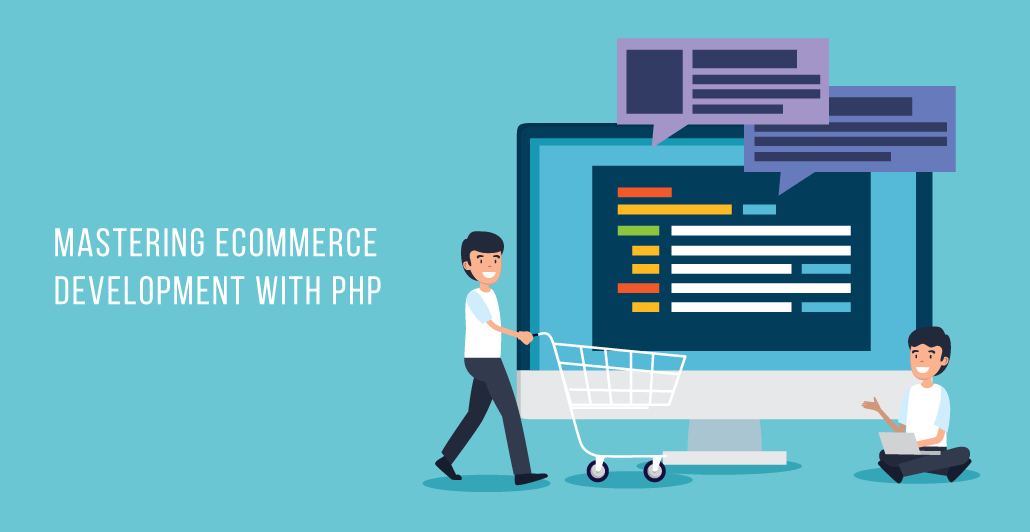Mastering eCommerce Development with PHP: A Step-by-Step Guide

We can’t deny that it is the age of entrepreneurs, and a major portion of entrepreneurs are in the eCommerce sector. E-commerce is an ever-growing industry. Thus, in the race to start new online businesses, several e-retailers are in this sector. So, due to the rapid growth of the e-commerce sector, this demands seamless online services. For this, an e-retailer needs eCommerce website development services. Hence, he must need a simple and organized framework, which is none other than PHP! Thus, eCommerce website development with PHP is the best option.
The development of an eCommerce platform requires knowledge of various technologies and skills. PHP is one of the common frameworks for developing web pages and softwares. Now, there are surely many questions that arise in your mind, and we have come up with this blog to answer your questions. We will guide you through the process of building a fully functional eCommerce platform with PHP.
Whether you are an experienced developer, a beginner, or an entrepreneur, this blog will help you enhance your knowledge and give relevant information.
So, let’s start reading and learn how and why eCommerce website development with PHP is the best.
WHAT IS PHP?
Programming language PHP stands for Hypertext Processor. It was developed in 1994 as a collection of CGI scripts by Rasmus Lerdorf. He utilizes it to monitor website traffic. Since then, it has evolved into a popular language for creating web pages. The most well-known websites in the world, like Wikipedia, Facebook, and WordPress, are all driven by it.
PHP is a versatile language that may be used as an HTML plugin or separate script. Its straightforward syntax makes it easy for programmers to develop web apps rapidly. PHP is a popular choice for creating data-driven websites and applications since it supports a wide range of databases.
WHY PHP IS GOOD FOR eCommerce WEBSITE DEVELOPMENT
Even after knowing its meaning, you may still be confused as to why PHP is good for eCommerce website development and why most eCommerce development services choose it. So, we will clear up your confusion here. Below are the reasons that you should go for e-commerce development with PHP:
1. Open-Source
It is free to use, edit, and distribute PHP because it is an open-source language for programming. This makes it the perfect option for small and medium-sized enterprises looking to develop their e-commerce.
2. Active Developer Community
This indicates that there is a lot of information, materials, and outside tools available for the creation of e-commerce websites. This makes it simpler to receive assistance with coding problems and to find answers to common problems.
3. Easy to learn
In comparison to other programming languages, PHP is simpler to learn. This means that even new developers can quickly get up to speed with PHP and start building eCommerce websites.
4. Flexibility
PHP is a highly flexible programming language, which means that it can be used to develop a wide range of eCommerce websites, from simple online stores to complex marketplaces with multiple vendors.
5. Integrates with popular e-commerce platforms
PHP integrates with popular eCommerce platforms. These platforms include Magento and WooCommerce. This means that developers can leverage the functionality of these platforms while still having the flexibility to customize the website to their specific needs.
6. Scalable
Due to PHP’s strong scalability, eCommerce websites created with it can process plenty of transactions and traffic without experiencing any lag or crashes. This is essential for eCommerce websites, which need to be able to handle a large number of simultaneous users.
STEPS FOR eCommerce WEBSITE DEVELOPMENT WITH PHP
1. Choose an eCommerce Platform
The first step in eCommerce website development with PHP is to choose a framework. An eCommerce framework is a pre-built software application that provides the necessary tools and functionality to build an online store. Some popular frameworks for developing your eCommerce include Laravel, Symfony, and CodeIgniter. Each has its strengths and weaknesses, so it is important to research and choose the framework that best meets your specific needs.
Choosing the right eCommerce frameworks is crucial for developing a successful eCommerce website, as they will provide the foundation for your site’s functionality and user experience.
2. Set Up Development Environment
After choosing an eCommerce framework, the next step is to set up your development environment. On your local machine, you usually need to install a web server like Apache and a database server like MySQL. You will also need to install the eCommerce framework and any required dependencies.
3. Design eCommerce Site
After setting up your development environment, you can begin with designing your eCommerce website. This involves creating wireframes, choosing a color scheme, and designing the layout of each page. The design of your site is critical to its success, as it will impact user engagement and conversion rates.
4. Create Database
After designing a site, you will need to create a database for eCommerce website development with PHP. This is to store product information, customer data, and order details. It involves setting up a database server and configuring your e-Commerce framework to connect to it. The database is the backbone of your eCommerce site, and it is important to set it up correctly to ensure smooth site functionality.
5. Build eCommerce Site
You can begin creating your eCommerce site after your database is ready. This involves writing PHP code to handle tasks. Such tasks involve product catalog display, shopping cart functionality, and payment processing. The eCommerce framework you chose will only provide a starting point for building your site, but you will need to customize it to meet your specific needs.
6. Test Site
Once you are done with developing your eCommerce site, Here’s the majorly important step, and that is testing. Just like other applications or websites, it is essential to test the eCommerce website too. To make sure it works properly, test it.Testing for bugs, security holes, and usability problems is part of this process. You will also need to test the performance of the site to ensure that it can handle high traffic volumes.
7. Launch Your Site
The final step for eCommerce website development with PHP is to launch or deploy the site to the public. This involves uploading a site to a web server, configuring the domain name settings, and setting up payment processing and shipping options.
Deploying your site feels like achieving milestones, but it is important to monitor the website from time to time. Keep making updates to ensure a positive user experience.
CONCLUSION
The process of eCommerce website development with PHP is not a simple task. However, with a proper understanding of tools and technicalities, one can assure successful development. E-commerce website development will be profitable for businesses. Additionally, one of the best approaches to developing an eCommerce website is by utilizing a PHP framework like Laravel. Laravel offers a robust set of features and functionalities to ensure scalability, security, and user-friendliness.
Furthermore, it will be more appropriate if you hire a PHP development company, hire PHP developers, or E-commerce Development Services. Lastly, all you need to understand are the steps and techniques to get the best app.
Also read: Top eCommerce Web Design Trends and Technologies




